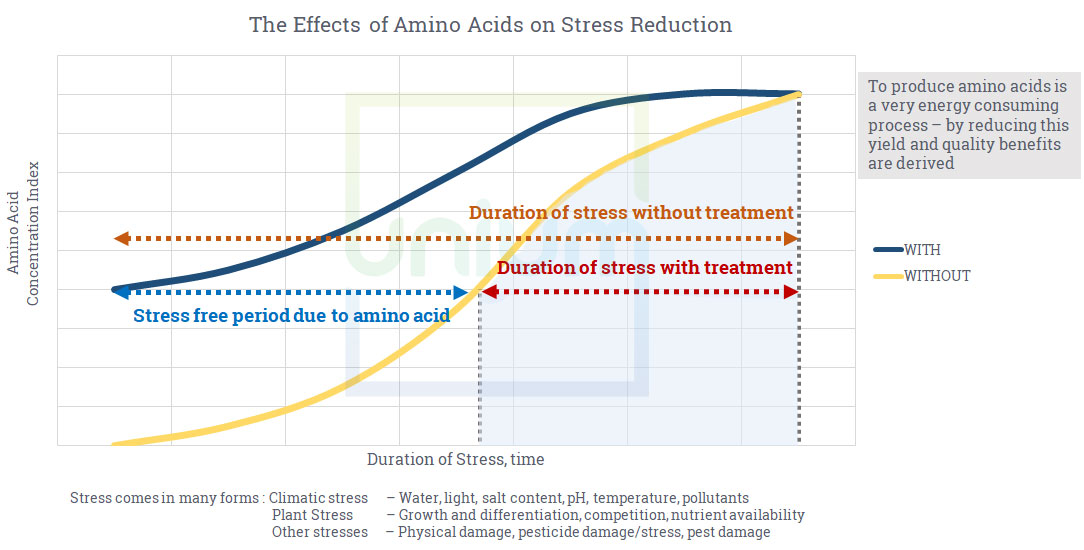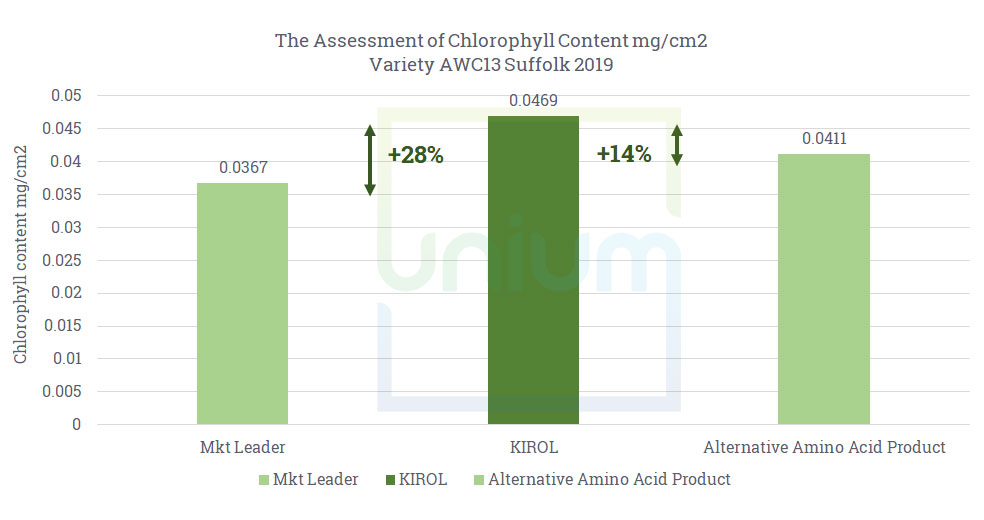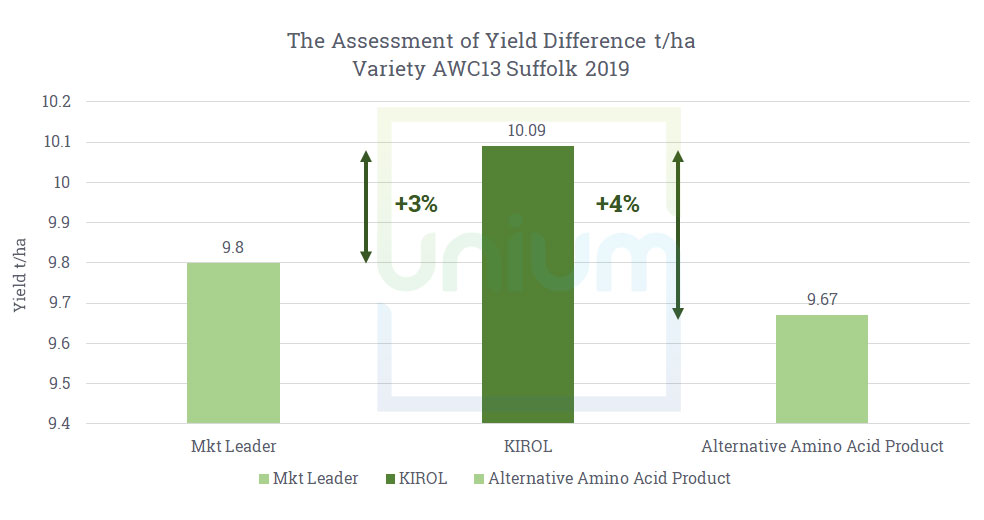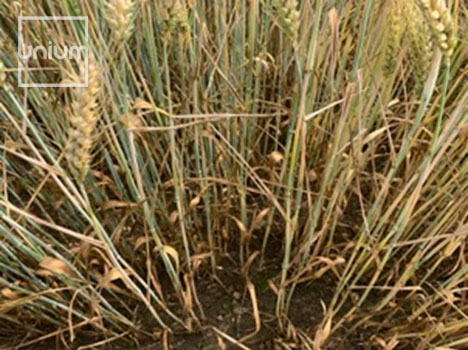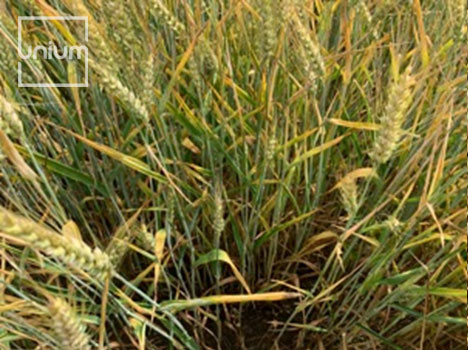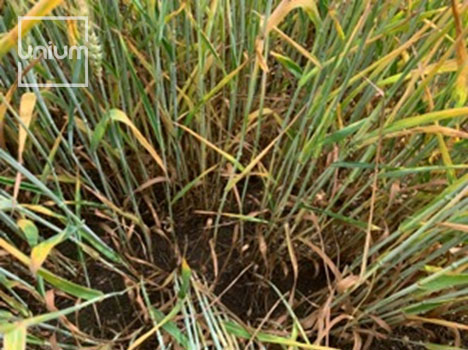Amino Acids – Kirol

Plants grow in a complex environment with multiple abiotic (non-living) and biotic (living) stresses affecting them. Focussing on the abiotic stresses – such as temperature; moisture; light and salinity; along with pesticide/fertiliser application – anything that moves these outside the normal tolerance range for the crop will create a stress.
It is estimated that 96.5% of the global rural land is affected by abiotic stresses (FAO world soil resource report 2000), hence why there has been an exponential growth in research to understand and to mitigate their effects on crop production.
These stresses can be invisible, transient (leaf mottling) or phytotoxic to the area and ultimately even cause plant death. This complexity makes it very difficult to predict the timing and magnitude of the stress and the impact it can have season by season and from crop to crop.
The plant has a dynamic and complex response to stress, depending on where in the plant it is encountered, e.g. roots, foliage, flowers or fruit, along with the intensity and duration of the stress event.
One of the first responses of the plant is the inhibition of protein synthesis (and its quality) and, if the stress continues, it starts to impact on carbohydrate and lipid synthesis as well as the process of photosynthesis itself.
Amino acids, of which there are over 700, are the basic building blocks to life. They are used to construct specific proteins and plants have the ability to synthesis all the amino acids they need. Plants synthesise/obtain amino acids from either decaying humus or from the primary elements, with carbon and oxygen obtained from air and hydrogen from water in the soil, forming carbon hydrate by means of photosynthesis which is then combined with nitrogen obtained from either the soil or from air. This enables the plant to synthesise amino acids via various metabolic pathways.
It’s not surprising that increasing chlorophyll will ultimately increase yield – build a bigger more efficient ‘factory’ and productivity goes up – but to take a look this closely is fascinating.
In every situation where we saw increased chlorophyll, there was also an increase in yield, even from seed treatments.
The graph above shows that applying active amino acids can reduce the stress period that the plant suffers and in doing so, reduces the energy that’s diverted from normal growth to mitigating the effect of stress.
Amino acids have many functions in plant physiology and like nutrients, they are required in different concentrations. There’s a minimum of 20 known “essential” amino acids that often work together as part of a complex, rather than in isolation. Some are required at higher levels than others, in a way that’s very similar to nutrients, but this isn’t an indication of their individual importance.
Typical Functions:
- Increase chlorophyll production
- Provide rich source of organic nitrogen
- Stimulate synthesis of vitamins
- Influence various enzymatic systems
- Flowering is stimulated
- Better fruit/seed setting
- Higher nutritional content, size, flavour, and coloration of fruits.
- Higher brix level (quality increase)
- Increased pest and pathogen resistance
- Open stomata
- Chelation and transportation of micronutrients
- Optimise growth under extreme conditions
- Increase pollen germination
- Cell wall stabilisation
Plants make their own proteins based upon a range of factors, including their specific stage of growth, nutritional demands and the stress they’re growing under. However, they can only effectively build the required proteins if the raw materials are present. Making amino acids is an energy intensive process, so providing additional L-amino acids via the roots or leaf tissue ensures that the plant has plenty of materials for building these important proteins. This means more energy is available for growth and differentiation.
Amino acids confer stress tolerance in several ways, depending upon the stress:-
- Heat stress – they improve photochemical efficiency and avoid the destruction of photosynthetic pigments.
- Cold stress – amino acids act as osmolytes by inducing a better regulation of the plants water status through increased stomatal conductance ion transport, but also by stimulating root growth.
- Herbicide stress – amino acids produce antioxidants to reduce cell stress and damage.
In general they protect enzymes, influencing gene expression and redox homeostasis. It has also been shown that amino acids can increase photosynthetic activity and chlorophyll content.
Our approach to using amino acids in crops is data-supported and involves applying the correct biostimulant at its most effective timing, both to mitigate stress and ensure a cost-effective return on investment.
The key criteria to consider when selecting amino acid products are as follows:-
- Only consider the active L-form when reading the label.
- The quality of the extraction is more important than the method (enzyme or chemical).
- Ensure you are applying the correct amount of active ingredient and not one based on budget. An ineffective dose will be the most expensive in the long run.
Research has shown amino acids can play a role in mitigating stress in key crops at specific timings, supporting them in reaching potential yield when used correctly.
The trials data below shows the effect of different amino acids and their relative concentration on chlorophyll production.
It’s an interesting area that requires more detailed experimentation to bring reliability and robustness to responses.


